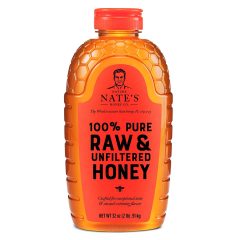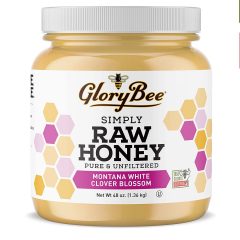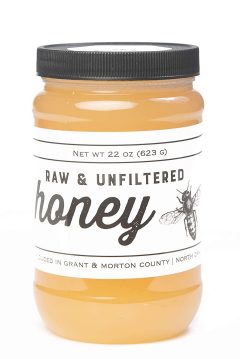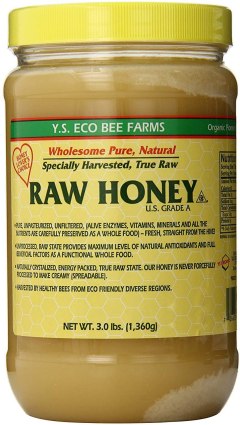BestReviews is reader-supported and may earn an affiliate commission. Details

This is the one to get if you want a delicious raw honey from a reputable company that focuses on quality.
This is the one to get if you want a delicious raw honey from a reputable company that focuses on quality.
Natural and unfiltered. Well-established brand since 1972. Tested for impurities, including pesticides and herbicides. Repeat customers rave about quality and flavor.
Some bottles arrived damaged and/or with broken seals. A few reports of crystallization.

Raw, unfiltered honey from the respected GloryBee brand.
Raw, unfiltered honey from the respected GloryBee brand.
Delicate, neutral flavor that's great for cooking or on its own. Pleasant creamy texture sets this honey apart from other raw products. Portion of profit goes to Save the Bee initiative.
Lid can be hard to remove as honey accumulates around the rim.

Our cooking expert loves the sustainability and traceability of this honey.
Our cooking expert loves the sustainability and traceability of this honey.
Non-GMO and MGO certified. Delicious in cooking, baking, and tea. Each bottle has a QR code for traceability. Authentic New Zealand Mānuka honey.
Much thicker consistency than other brands.

Delicious honey produced in southwest North Dakota; one of our expert's favorites.
Delicious honey produced in southwest North Dakota; one of our expert's favorites.
Contains beneficial pollen and enzymes that raw honey enthusiasts love. Mild taste with undertones of cinnamon. Unfiltered and has a thick consistency.
Plastic packaging is less durable and environmentally friendly than glass.

A quality raw honey with a consistency that makes it almost like a spread.
A quality raw honey with a consistency that makes it almost like a spread.
Raw, unfiltered honey; U.S. Grade A. Thick and easy to spread on foods like biscuits and toast. Has a pleasant flavor. Large 3-pound jar for a reasonable price.
Comes in plastic jars that aren't sealed very well. Not organic. A few owners found the label confusing and question if it's pasteurized.

We recommend these products based on an intensive research process that's designed to cut through the noise and find the top products in this space. Guided by experts, we spend hours looking into the factors that matter, to bring you these selections.

Not only is it delicious and sweet, but the right honey is good for you. It can be rich in nutrients and antioxidants, soothe your throat, and possibly even help lower your blood pressure. Honey comes in a wide variety of flavors with no two jars tasting exactly the same, and it is recognized as the only fresh food that doesn’t spoil.
If you’re looking for honey that has all of these benefits, you need to find raw honey. Different from regular honey, raw honey hasn’t been pasteurized and filtered to the point of eradicating most of its beneficial properties. Many types of regular honey also contain unhealthy additives like high-fructose corn syrup.

When purchasing honey, the first thing to consider is the different types: regular, raw, and organic.
Regular honey is mostly what you find on grocery shelves. If it doesn’t say “raw” on the label, it is not raw honey. Regular honey is subjected to pasteurization and filtration, which makes the honey safer to eat, but those processes also destroy many of the natural benefits of raw honey. Most notably, regular honey may not contain any bee pollen, which is so beneficial that some countries recognize it as a medicine. Additionally, regular honey may contain additives, such as added sugar and high-fructose corn syrup.
Because raw honey is sold in its natural state, unpasteurized and unfiltered, it retains all its vitamins, minerals, amino acids, enzymes, and bee pollen. It is possible that trace elements of undesirables, such as venom or bee parts, may find their way into raw honey as well. However, raw honey contains polyphenols that act as antioxidants in the human body. If you are looking beyond sweetness for the healthier option, raw honey is the way to go.
Organic honey is not necessarily raw honey. Rather, it means the flowers, bees, and honey are not permitted to come into contact with chemicals like pesticides and herbicides. However, organic honey may be pasteurized and filtered like regular honey, which removes much of the honey’s beneficial properties. For the very healthiest honey, look for a product that is labeled as both organic and raw.




















The other features to take into account when buying honey come down to matters of personal taste and preference.
How much honey do you use? Since honey doesn’t spoil, if it’s more economical to buy a larger jar or even to purchase in bulk, that might be a wiser choice.
The color of honey offers more than just aesthetic appeal. Typically, the darker the color, the more intense the flavor.
Honey typically comes in two different textures, either the sticky liquid that most people are familiar with or a buttery cream. Liquid honey is usually pasteurized but not always – it depends on how hot the honey was heated. Honey can also crystalize over time, but that texture can be smoothed by slightly warming the honey while slowly stirring.
The flavor of honey comes from the flowers the bees visited. If you discover a fondness for a particular flavor, such as tupelo, search for that type of honey. If you’d like to explore your options, there is a wide variety of honey flavors to choose from.
Many individuals prefer honey from their area. But if you’d like to expand your palate, consider honey from other locales and different countries.
If you have concerns about how the honey you are considering is harvested, look for honey that is True Source-certified. True Source is a voluntary system that allows honey manufacturers to be transparent, certifying that their sourcing practices are in full compliance with U.S. and international trade laws.
Sometimes honey labeled as pure may be diluted. You can test the purity of your honey by putting a tablespoon or two in a small bowl, covering it with warm water, and swirling it in a circular motion for a minute or two. Thick honey takes on a hexagonal pattern. Diluted honey, which is often thinner, either comes up as a misshapen pattern or no pattern at all.
Don’t be swayed by price alone. Though the best honey may cost a little more than you were expecting, that is not to say you can’t find exceptional honey at a lower price. In the $5 to $10 price range, you’ll find jars of mostly wildflower and clover honey that is a golden or amber in color.
From $10 to around $17, you can find local honey along with jars that have been infused with other ingredients, such as ginger, lemon, and additional pollen. The honey may come in glass jars instead of squeeze bottles at this price.
From $18 to $30, you’ll find specialized products, such as tupelo honey and manuka honey. For over $30, you should be cautious and do your research because the higher price does not always translate to a better product.

Honey is most often named for the nectar of the flower it contains. In the United States, there are roughly 300 different types of honey. To give you an idea of what is available, here are some of the more common varieties of honey.

A. This is one of the most hotly debated issues in the world of honey. The answer depends on who you ask. Taking a spoon of honey won’t stop you from sneezing, but some doctors believe local honey can work like allergy shots by helping you build up an immunity to local pollen. Other doctors state that the allergens found in local honey are not the ones that bring about sneezing fits. However, honey has been proven to suppress coughs, and it has some anti-inflammatory effects – inflammation is part of an allergic reaction – so the debate continues.
A. Never give honey to a child who is younger than 12 months old because it contains a bacteria that can cause botulism. Infant botulism is treatable if caught early. The symptoms can begin as soon as 18 hours after ingestion and include constipation, weak muscles (which shows up as floppy movements), weak cry, irritability, drooling, paralysis, and more. The sooner you get medical treatment, the better.
A. No. One of the many wonders of honey is that it is the only food that doesn’t spoil. Processed honey, however, may not last forever because vital elements have been filtered out. The crystallization of honey does not mean it has gone bad. In fact, if you simply place the jar of crystallized honey in a container of warm water and stir it gently, those crystals will dissolve.
Get emails you’ll love.
Learn about the products you’re wondering if you should buy and get advice on using your latest purchases.
